After four long years of development and two iFixit teardowns of pre-release versions, the highly anticipated, OMG, real-deal Oculus Rift is finally here! Humans have been pretty sure for a long time now that the Oculus Rift is gonna be dope. Our engineers can now confirm that it totally is. Cue the teardown. (Fair warning: this is going to get a little Hard Sci-Fi—we’re just really excited, okay?)
This time ‘round, Oculus ditched the interchangeable lenses in favor of a pair of built in lens-mounted displays (this appeared in the 3rd prototype, Crescent Bay, that we never got our hands on). In addition to the newly improved interpupillary distance adjustment, the asymmetric lens shapes also allow users to focus the displays to suit their eyes by moving the headset up and down. No more swapping lenses or complex adjustments for your differently-sighted friends. The sweet tech behind this fancy focus is a hybrid Fresnel lens. The use of thin concentric rows of prisms instead of a huge bulging curved lens cuts down on weight, but at the same time, the entire lens does slightly vary in thickness along a gentle curve, which gradients the focusing power as you shift the lens up or down. Combining the best of Fresnel and traditional lenses makes for some sick optics.
Coupled with the improved head tracking, this headset is serving you all the VR you can possibly handle. IR LEDs around the front of the headset and the back of the headband leave no blind spots for the Constellation LED array, and no interruption in immersion (until you trip over the cord—or a chair).
Oculus Rift CV1 teardown highlights:
• Stretchy black lycra surrounds the lenses, covering a thin plastic frame. This dustproof fabric cleverly protects the Oculus’ innards, while still allowing the adjustable lenses some freedom to move.
• The Oculus is packing 2 OLED displays for 2x the fun, with a pixel density of 456 ppi—putting it right between the iPhone 6s Plus (401 ppi) and the Galaxy S7 (576 ppi) displays. At that pixel density, the average user would need to be about 8 inches from the display for the pixels to become indistinguishable. But, thanks to the Fresnel lens design, the perceived distance is great enough to achieve this effect with a much smaller footprint.
• The Rift scored a respectable 7/10 on our repairability scale. The intricate design makes it difficult to remove the lenses, displays, motherboard, and head strap without causing some serious damage, but at least the earpiece speakers and face pad are easy to remove and replace. We were also impressed to see improved cable management across the generations of Rift.
For all of our juicy VR findings, head over to the full teardown.






0 件のコメント